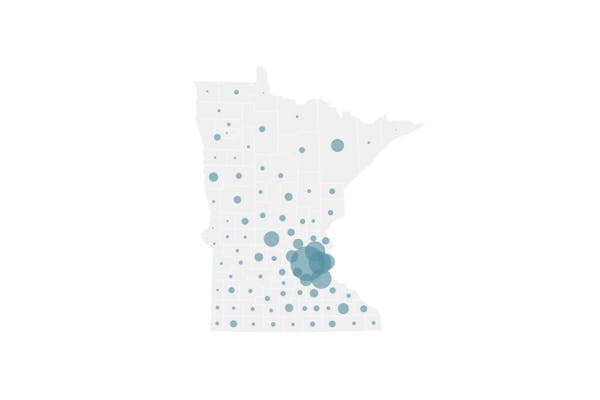Sixteen COVID-19 deaths were reported Friday in Minnesota along with 1,877 infections with the novel coronavirus that causes the respiratory disease.
The daily figures raise Minnesota's totals to 7,144 COVID-19 deaths and 575,812 diagnosed infections in the pandemic — with the state on the apparent downside of a third wave of viral spread.
The seven-day average positivity rate of COVID-19 testing rose from 3.5% on March 3 to 7.5% on April 8, but has since declined to 6.3%. Hospitalizations of COVID-19 cases similarly increased from 210 on March 6 to 699 on April 14, but declined as of Thursday to 619.
State health officials remain concerned about the emergence of more infectious variants, and encouraged people to seek COVID-19 vaccine now that supplies have stabilized in Minnesota. The state is among the fastest in the U.S. for vaccine administration — with more than 2.5 million people in Minnesota receiving some vaccine and nearly 1.9 million of them completing the one- or two-dose series.
Roughly 57% of Minnesota's eligible population of people 16 and older have received vaccine, including nearly 87% of senior citizens who are more vulnerable to severe COVID-19, but demand appears to be waning. The federal vaccine site at the Minnesota State Fairgrounds started providing some shots to people without appointments this week, and Allina Health opened its vaccine appointments to anyone 16 and older, regardless of whether they are active patients in the health system.
The state also is dropping its measurement of providers on whether they administer 90% of the doses they receive within three days, said Kris Ehresmann, state infectious disease director.
"Speed remains a priority, of course, because vaccine sitting unused does no one any good," she said. "But a bit more flexibility is now going to be helpful as the supply-demand equation shifts."
State Health Commissioner Jan Malcolm encouraged people to seek vaccine, wear masks in crowded locations, practice social distancing and stay home when sick.
"As much as we feel like things are improving, there is still a lot of virus out there," she said.
An estimated 60 to 70% of infections in Minnesota right now are believed to be caused by a more infectious B.1.1.7 variant first identified in England.
The state also has found 88 infections involving the B1351 variant first found in South Africa and 65 involving the P.1 variant first found in Brazil.
The hospitalization rate is higher in these two infection groups, and the average age of the hospitalized patients is only 37, Ehresmann said. "We're seeing these variants impacting younger ages, we're seeing higher case severity and we're seeing more evidence of domestic transmission."
Jeremy Olson • 612-673-7744

Want to share info with the Star Tribune? How to do it securely

'Safe recovery sites' would offer syringes, naloxone and more to people using drugs. The plan could be in peril.
New Minnesota GOP leaders seek peace with party's anti-establishment wing

Who is Republican Lisa Demuth, Minnesota's first House speaker of color?

